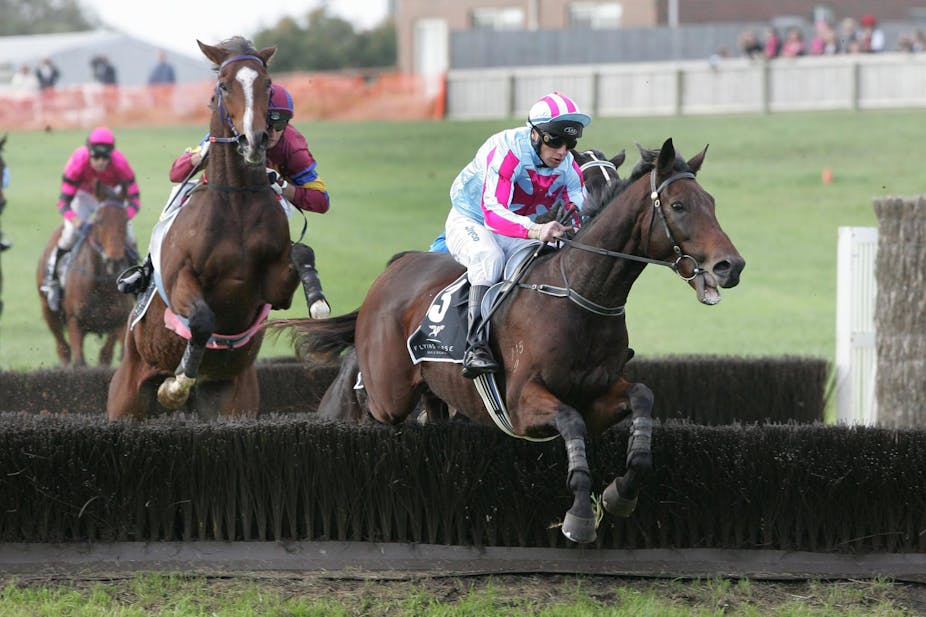On the opening day of the Warrnambool jumps carnival in western Victoria this year, five-year-old horse Casa Boy died when he fell at his first hurdle.
Just one month later, Shine the Armour also died while trying to negotiate a hurdle. That death was attributed to either a heart attack or a broken neck due to the impact of his fall.
By week six of the 2011 jumps season, six horses were dead.
Shine the Armour’s death prompted RSPCA Victoria’s president Hugh Wirth to describe Warrnambool as “the killing fields for horses.”
But despite Wirth’s words, I’m glad Shine the Armour and Casa Boy are dead.
While Casa Boy’s death was very disappointing from his perspective – his life was cut short, his fall may have been painful, and the manner of his death was probably frightening. But I’m still glad he is dead.
The reason I am pleased is that the Australian racing industry has a dirty secret.
Casa Boy and Shine the Armour’s deaths, not to mention Banna Strand’s riderless detour through the crowd on May 5th at Warrnambool’s Grand Annual Steeplechase, resulting in seven people being taken to hospital, has shone the spotlight on the so called “sport of kings”.
Those incidents provide people like me, who are aware of the Australian racing industry’s dark side, the opportunity to speak up.
For every 1000 horses bred by the Australian racing industry only 300 will ever actually race.
The Australian racing industry accounts for 17% of all racehorses born each year worldwide.
The horses that don’t ever race are most likely slow, or lacking in potential for some other reason.
Some horses race at a young age, but compete only a few times because being deemed unlikely to win or before they succumb to injury.
The phenomenon of breeding horses that do not race is referred to as “wastage”.
But what happens to all the waste?
Very few opportunities exist for failed racehorses. There is no magical paddock or “farm” where thousands of unwanted racehorses are whiling away the years.
Knackeries around Australia are able to kill and process horses, but in most cases the meat will be deemed unfit for human consumption and will typically become pet food.
In 1991, an estimated 7,500 horses were killed and processed for pet food.
Australia does have two abattoirs that process horses for human consumption: one in Caboolture, Queensland and the other in Petersborough, South Australia.
As horse is not a socially acceptable meat among mainstream Australian society, horses processed at those abattoirs are normally sold to the export market, the biggest of which are France, Italy, Belgium, Switzerland, the Netherlands, Russia and Japan.
A report by Massey University Masters student Amanda Doughty found that at one export quality abattoir between November 2007 and January 2008, 52.9 percent of the horses processed had originated in the racing industry.
No other sector is more responsible for breeding unwanted horses than the Australian racing industry.
The unsuccessful racehorses that do not end up as either cat food or on someone’s dinner plate may find themselves at a jumps racing meet.
While those animals may have escaped death for the moment, chances are they are going to pay a high price for being unable to run fast enough.
Victoria and South Australia are the only states in Australia that still allow jumps racing.
New South Wales banned it in 1995 and it’s easy to see why.
While Shine the Armour and Casa Boy’s deaths made headlines, many other horses regularly fall as they are coaxed by jockeys, whip in hand, to run and jump at steeples and hurdles.
Research by Dr Lisa Boden suggests that horses are 3.5 times more likely to die in jumps races compared to flat races.
In August 1991, the Australian Parliament concluded an inquiry into jumps racing.
The Senate Select Committee on Animal Welfare found “there is an inherent conflict between these activities [jumps racing] and animal welfare. Accordingly, the Committee is of the view that relevant State Governments should phase out jumps racing over the next three years.”
The Committee also found that no amount of education, training, and alterations to the height or placement of hurdles would stop the fatalities.
Jumps racing simply has to be phased out.
On the first Tuesday in November a crowd of around 700 million people in 120 countries watches the Melbourne Cup.
But how many of those spectators are aware of the volume of racehorses that are bred by the racing industry each year?
How many of those same racegoers know what proportion of those horses end up at the abattoir because they are not fast enough to race?
I suspect not very many.
My view is that such ignorance is a terrible shame.
While our eyes are diverted by the glitz and glamour of the Melbourne Cup reasonable people, who would not want to see an animal suffer, can’t and don’t speak up in defence of all those horses whose only failing was that they can’t run fast enough to make a profit for their race industry masters.
They don’t speak up because they simply don’t know.
What a terrible shame. What a terrible waste.

